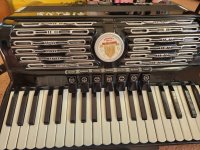KiwiSqueezer
Active member
I'm the first to admit that I don't know much about accordions, but I thought I was getting to grips with the ideas behind musette tuning(s).
Some time ago, I asked the forum about what I termed 'pseudo-musette' tuning, with reeds not exactly an octave apart. I was thinking about an LMH reed set, with appropriately sharpened H reeds. The idea was greeted with some scepticism. Now, however, it seems that something like it made it into production.

This accordion must be rather unusual. It presumably has LMM reeds; it provides 'musette' voices by M1M2 ("fr. muset" - French musette?), LM1M2 ("accordion"), which seem conventional enough, but then there is what I take to be LM2 ("bass muset") - which seems to be the 'pseudo-musette' idea, and then M2 on its own ("melodeon"), which is, I believe, quite unusual.
Is this as unusual as I think? Any ideas or comments? What type of music would this have been aimed at?
Some time ago, I asked the forum about what I termed 'pseudo-musette' tuning, with reeds not exactly an octave apart. I was thinking about an LMH reed set, with appropriately sharpened H reeds. The idea was greeted with some scepticism. Now, however, it seems that something like it made it into production.

This accordion must be rather unusual. It presumably has LMM reeds; it provides 'musette' voices by M1M2 ("fr. muset" - French musette?), LM1M2 ("accordion"), which seem conventional enough, but then there is what I take to be LM2 ("bass muset") - which seems to be the 'pseudo-musette' idea, and then M2 on its own ("melodeon"), which is, I believe, quite unusual.
Is this as unusual as I think? Any ideas or comments? What type of music would this have been aimed at?
